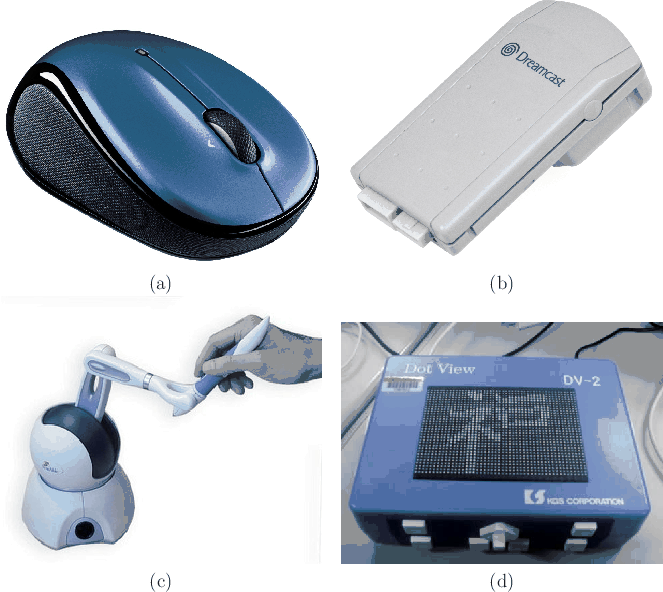
Next: Touch feedback via augmented Up: 13.1 Touch and Proprioception Previous: Somatosensory illusions Contents Index
Touch sensations through engineered devices are provided through many disparate systems. Figure 1.1 from Section 1.1 showed a system in which force feedback is provided by allowing the user to push mechanical wings to fly. Furthermore, a fan simulates wind with intensity that is proportional to the speed of the person virtually flying. The entire body also tilts so that appropriate vestibular stimulation is provided.
 |
Figure 13.4 shows several more examples. Figure 13.4(a) shows a PC mouse with a scroll wheel. As the wheel is rotated with the middle finger, discrete bumps are felt so that a more carefully calibrated movement can be generated. Figure 13.4(b) shows a game controller attachment that provides vibration at key points during an experience, such as an explosion or body contact.
Many haptic systems involve using a robot arm to apply force or pressure at precise locations and directions within a small region. Figure 13.4(c) shows such a system in which the user holds a pen that is attached to the robot arm. Forces are communicated from the robot to the pen to the fingers. As the pen strikes a virtual surface, the robot provides force feedback to the user by blocking its motion. The pen could be dragged across the virtual surface to feel any kind of texture [241]; a variety of simulated textures are presented in [51]. Providing such force feedback in important in the development of medical devices that enable doctors to perform surgical procedures through an interface that is connected to a real device. Without accurate and timely haptic feedback, it is difficult for doctors to perform many procedures. Imagine cutting into layers of tissue without being able to feel the resistant forces on the scalpel. It would be easy to push a bit too far!
Figure 13.4(d) shows a haptic display that is arranged much like a visual display. A rectangular region is indexed by rows and columns, and at each location a small pin can be forced outward. This enables shapes to appear above the surface, while also allowing various levels of pressure and frequencies of vibration.
All of the examples involve haptic feedback applied to the hands; however, touch receptors appear all over the human body. To provide stimulation over a larger fraction of receptors, a haptic suit may be needed, which provides forces, vibrations, or even electrical stimulation at various points on the suit. A drawback of these systems is the cumbersome effort of putting on and removing the suit with each session.
Steven M LaValle 2020-01-06